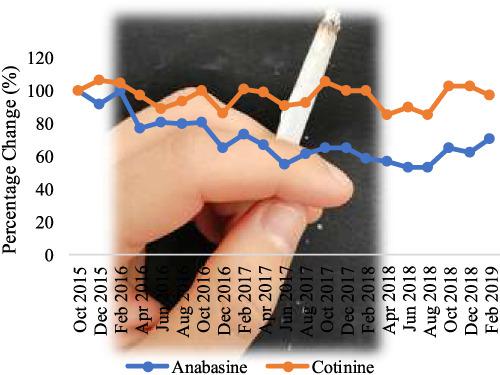当前位置:
X-MOL 学术
›
Drug Test. Anal.
›
论文详情
Our official English website, www.x-mol.net, welcomes your
feedback! (Note: you will need to create a separate account there.)
Anabasine-based measurement of cigarette consumption using wastewater analysis.
Drug Testing and Analysis ( IF 2.6 ) Pub Date : 2020-06-26 , DOI: 10.1002/dta.2874 Richard Bade 1 , Jason M White 1 , Benjamin J Tscharke 2 , Maulik Ghetia 1 , Ahmed Abdelaziz 1 , Cobus Gerber 1
Drug Testing and Analysis ( IF 2.6 ) Pub Date : 2020-06-26 , DOI: 10.1002/dta.2874 Richard Bade 1 , Jason M White 1 , Benjamin J Tscharke 2 , Maulik Ghetia 1 , Ahmed Abdelaziz 1 , Cobus Gerber 1
Affiliation

|
Community tobacco use can be monitored over time using wastewater‐based epidemiological approaches by estimating the mass loads of nicotine and its metabolites, cotinine, or hydroxycotinine, in wastewater. However, due to the use of nicotine in smoking cessation products, other sources of nicotine contribute to cotinine and hydroxycotinine loads. The use of nicotine replacement therapies could vary in space and time and mask the true rates of tobacco consumption. Therefore, this work evaluated the content of tobacco specific markers, anatabine and anabasine, in cigarettes, in urine of smokers, and in wastewater. The results indicated that the anabasine content in both licit and illicit cigarettes in Australia is less variable than anatabine and is therefore considered a better measure of tobacco consumption. A study determining the excretion of tobacco‐specific alkaloids of smoking and non‐smoking volunteers gave an average urinary mass load of anabasine of 4.38 μg/L/person and a daily mass load of 1.13 μg/day/person. Finally, this was compared with the mass loads of anabasine from wastewater‐based epidemiology data of 3 μg/day/person to estimate cigarette rates in a South Australian city: equivalent to 2.6 cigarettes/person/day. The rate of decline of cigarette use was greater when using anabasine as a measure of consumption compared with cotinine. This is the first study to estimate the rate of anabasine excretion, which can be used to estimate tobacco use independent of therapeutically prescribed nicotine.
中文翻译:

使用废水分析基于 Anabasine 的卷烟消费量测量。
通过估算废水中尼古丁及其代谢物可替宁或羟可替宁的质量负荷,可以使用基于废水的流行病学方法随时间监测社区烟草使用情况。然而,由于在戒烟产品中使用了尼古丁,其他尼古丁来源会导致可替宁和羟可替宁负荷。尼古丁替代疗法的使用可能在空间和时间上有所不同,并掩盖了烟草消费的真实率。因此,这项工作评估了香烟、吸烟者尿液和废水中烟草特定标记物 anatabine 和 anabasine 的含量。结果表明,澳大利亚合法和非法卷烟中的大麻素含量比大麻素变化更小,因此被认为是衡量烟草消费量的更好方法。一项确定吸烟和不吸烟志愿者的烟草特异性生物碱排泄的研究显示,anabasine 的平均尿质量负荷为 4.38 μg/L/人,每日质量负荷为 1.13 μg/天/人。最后,将其与基于废水的流行病学数据中 3 微克/天/人的 anabasine 质量负荷进行比较,以估计南澳大利亚城市的卷烟率:相当于 2.6 支卷烟/人/天。与可替宁相比,当使用 anabasine 作为消费量度时,卷烟使用量的下降速度更快。这是第一项估计 anabasine 排泄率的研究,该研究可用于估计烟草使用情况,独立于治疗处方的尼古丁。38 μg/L/人,每日质量负荷为 1.13 μg/天/人。最后,将其与基于废水的流行病学数据中 3 微克/天/人的 anabasine 质量负荷进行比较,以估计南澳大利亚城市的卷烟率:相当于 2.6 支卷烟/人/天。与可替宁相比,当使用 anabasine 作为消费量度时,卷烟使用量的下降速度更快。这是第一项估计 anabasine 排泄率的研究,该研究可用于估计烟草使用情况,独立于治疗处方的尼古丁。38 μg/L/人,每日质量负荷为 1.13 μg/天/人。最后,将其与基于废水的流行病学数据中 3 微克/天/人的 anabasine 质量负荷进行比较,以估计南澳大利亚城市的卷烟率:相当于 2.6 支卷烟/人/天。与可替宁相比,当使用 anabasine 作为消费量度时,卷烟使用量的下降速度更快。这是第一项估计 anabasine 排泄率的研究,该研究可用于估计烟草使用情况,独立于治疗处方的尼古丁。与可替宁相比,当使用 anabasine 作为消费量度时,卷烟使用量的下降速度更快。这是第一项估计 anabasine 排泄率的研究,该研究可用于估计烟草使用情况,独立于治疗处方的尼古丁。与可替宁相比,当使用 anabasine 作为消费量度时,卷烟使用量的下降速度更快。这是第一项估计 anabasine 排泄率的研究,该研究可用于估计烟草使用情况,独立于治疗处方的尼古丁。
更新日期:2020-06-26
中文翻译:

使用废水分析基于 Anabasine 的卷烟消费量测量。
通过估算废水中尼古丁及其代谢物可替宁或羟可替宁的质量负荷,可以使用基于废水的流行病学方法随时间监测社区烟草使用情况。然而,由于在戒烟产品中使用了尼古丁,其他尼古丁来源会导致可替宁和羟可替宁负荷。尼古丁替代疗法的使用可能在空间和时间上有所不同,并掩盖了烟草消费的真实率。因此,这项工作评估了香烟、吸烟者尿液和废水中烟草特定标记物 anatabine 和 anabasine 的含量。结果表明,澳大利亚合法和非法卷烟中的大麻素含量比大麻素变化更小,因此被认为是衡量烟草消费量的更好方法。一项确定吸烟和不吸烟志愿者的烟草特异性生物碱排泄的研究显示,anabasine 的平均尿质量负荷为 4.38 μg/L/人,每日质量负荷为 1.13 μg/天/人。最后,将其与基于废水的流行病学数据中 3 微克/天/人的 anabasine 质量负荷进行比较,以估计南澳大利亚城市的卷烟率:相当于 2.6 支卷烟/人/天。与可替宁相比,当使用 anabasine 作为消费量度时,卷烟使用量的下降速度更快。这是第一项估计 anabasine 排泄率的研究,该研究可用于估计烟草使用情况,独立于治疗处方的尼古丁。38 μg/L/人,每日质量负荷为 1.13 μg/天/人。最后,将其与基于废水的流行病学数据中 3 微克/天/人的 anabasine 质量负荷进行比较,以估计南澳大利亚城市的卷烟率:相当于 2.6 支卷烟/人/天。与可替宁相比,当使用 anabasine 作为消费量度时,卷烟使用量的下降速度更快。这是第一项估计 anabasine 排泄率的研究,该研究可用于估计烟草使用情况,独立于治疗处方的尼古丁。38 μg/L/人,每日质量负荷为 1.13 μg/天/人。最后,将其与基于废水的流行病学数据中 3 微克/天/人的 anabasine 质量负荷进行比较,以估计南澳大利亚城市的卷烟率:相当于 2.6 支卷烟/人/天。与可替宁相比,当使用 anabasine 作为消费量度时,卷烟使用量的下降速度更快。这是第一项估计 anabasine 排泄率的研究,该研究可用于估计烟草使用情况,独立于治疗处方的尼古丁。与可替宁相比,当使用 anabasine 作为消费量度时,卷烟使用量的下降速度更快。这是第一项估计 anabasine 排泄率的研究,该研究可用于估计烟草使用情况,独立于治疗处方的尼古丁。与可替宁相比,当使用 anabasine 作为消费量度时,卷烟使用量的下降速度更快。这是第一项估计 anabasine 排泄率的研究,该研究可用于估计烟草使用情况,独立于治疗处方的尼古丁。











































 京公网安备 11010802027423号
京公网安备 11010802027423号